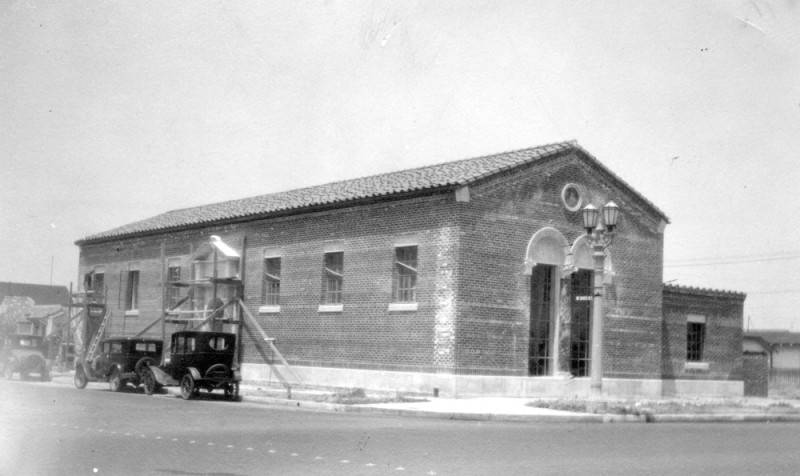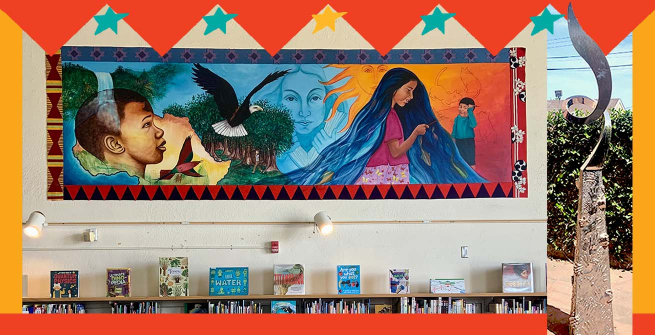The John Muir Branch Library was built in 1930, based upon a design by architect Henry Francis Withey in the Italian Renaissance style, and is listed in the National Register of Historic Places. The branch was expanded and renovated in the 1990s due to structural damage from the 1987 Whittier Narrows earthquake and to prevent future earthquake damage. The closure during this time saved the building from the fate of its temporary mini-mall location on Vermont Avenue, which was destroyed by arson during the 1992 riots, resulting in a catastrophic loss of its collection. A matching grant from the J. Paul Getty Trust and a donation campaign by director/choreographer Debbie Allen raised money to replace the holdings at the John Muir and Junipero Serra branch libraries, both destroyed during the riots. Renovation and retrofitting of the original John Muir building was completed, and the branch reopened on November 6, 1997. A special 25th reopening anniversary celebration is set for Friday, November 4, 2022.



The library is home to two public artworks: Viewpoint, a stainless steel sculpture by James T. Russell, and a multicultural folktale-themed mural by Cynthia Reyes Aponte. Both artworks were created by commissions awarded by the Los Angeles Cultural Affairs Department. Designed to help the city heal and recover in the aftermath and devastation of the riots, it was hoped that public art commissions would spark dialogue, discussion, and involvement.
The artwork would reflect the diversity of viewers by actually mirroring its environment and those who come in contact with it. It is my intent for my sculptures to entice the viewer to continue to look at them since they constantly change as the surrounding activities change. —James T. Russell
James T. Russell (1938-2017) was a prolific sculptor and long-time Lomita resident known for his monumental polished stainless steel sculptures. His work includes both public art and private commissions. Examples of Russell’s art locally include Voyagers (1977) at California State University, Long Beach; Angelic Duet (1979), commissioned for the State of California Art in Public Buildings program and originally installed at the southeast corner of Broadway and First Street, which was relocated and rededicated in 2010 to the Cerritos Towne Center; Intercept (1984) at Cerritos Auto Square; Triumph (1997) in front of Allstate Insurance Headquarters Plaza in Glendale; and the 20-foot-high Cerritos Veterans Memorial (2006) in honor of those fallen serving our nation.
The sculpture’s design will symbolize the library’s solid historical base in the community in the foundation, moving into an unmarred freeform which suggests hope of the future. The contrast of the textured handprints to the smooth, polished surface will invite viewers to approach the sculpture. The viewer can have a relationship with the sculpture by touching the rough topography of the lower section and seeing their reflected image in the mirror-like upper surface. People are encouraged to have a relationship with the sculpture by a design that invites interaction through its sight and surface. —James T. Russell
The sculpture Viewpoint (1997) soars nine feet high in the courtyard of the branch, its top stainless steel form like a Möbius strip caught in fluid mid-turn, reaching to the sky. The cast handprints impressed into the triangular base provide a tactile, impasto-like counterpoint to the reflective polished steel of the top form. These handprints belong to community members and also to the artist himself, incorporating the artist’s intent to symbolize the importance and rootedness of the library within and as a part of the community. A plaque on the wall just inside from the courtyard bears the names of those community members whose handprints are impressed upon the sculpture.





The mural was commissioned as a healing project for the community after the 1992 riots. Something that would bring pride and honor to the multicultural community. —Cynthia Reyes Aponte
Cynthia Reyes Aponte is a multidisciplinary artist (drawing, painting, jewelry, and clothing design) who continues to create art, but no longer does so professionally. In addition to the John Muir Branch Library’s mural, she created another public art commission for the Los Angeles Public Library at the Cypress Park Branch, installed in 2003. The artist describes the mural as chronicling “the founding of Los Angeles as a farming community and the crucial role the Los Angeles River played in choosing the site for the city…and the importance of the transcontinental railroad bringing people from the east coast to settle in L.A.” Her other public artworks include Celebration of Life (1985), a mural on the south wall of the El Pueblo Neighborhood Center in Tucson, Arizona; and murals in the children’s rooms at various branches of the Orange County Public Library (San Juan Capistrano, Westminster, and Irvine Heritage Park), painted while she worked for the system in the 1990s.


Reyes Aponte’s vibrant and evocative Multicultural Folktale Mural (1994) graces the wall of the John Muir Branch Library’s children’s reading room, depicting, from left to right: African folktales, including that of the lightning bird; the Zuni Eagle Boy legend; the American folktale of Johnny Appleseed; the Aztec legend of Xochitl and Huitzilin; the Oaxacan Zapotec Indians’ legend of Lucia Zenteno, “The Woman Who Outshone the Sun”; and the Japanese folktale, The Boy Who Drew Cats. The images are framed within multicultural designs of the African bow tie pattern or hourglass shape (many meanings, but may symbolize unity); a star quilt pattern used by Native Americans to represent the morning star (symbolizing the link between the living and the dead and new beginnings); a triangle pattern used by different cultures including Africans and Native Americans (symbolizing balance, harmony, and ascension); Japanese cherry blossoms (sakura) represent spring, renewal, the ephemeral nature of life, and rebirth; and tomoe (a symbol used by the samurai due to its association with a Shinto war deity) are thought to represent the cycle of life.
The creation of the mural was inspired by the South Los Angeles community that had been devastated by the 1992 riots and was truly a family affair. Her brother was working to restore the power lines throughout Los Angeles following the riots, and his daughter served as the model for Lucia Zenteno, “The Woman Who Outshone the Sun.” Reyes Aponte’s son–in elementary school at the time—actually drew the cats for the part of the mural depicting the Japanese folktale, The Boy Who Drew Cats. In a mirroring of the folktale, the family cat, upon seeing her son’s drawing, reacted as if it were a real cat. (In the folktale, the boy’s drawings of cats come to life and save the young artist from the Goblin Rat, then return to the wall upon which they were drawn.)
Libraries are grounded in the communities they serve and seek to provide resources and information specific to those communities. They anchor and embody the core of the community, symbolizing knowledge, democracy, equity, and empowerment. Like libraries, public art can not only serve as a reflection of a community but can speak to its past and future to encapsulate the spirit of what makes it unique. When so much is lost, there is still community. When so much is lost, art can be a balm to the soul. Art has the power to speak to us in ways that sometimes words cannot, the power to heal us with its beauty, the power to provoke and inspire, and the power to rise—and to help us rise—from the ashes.












